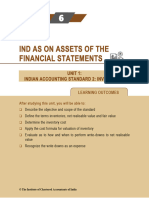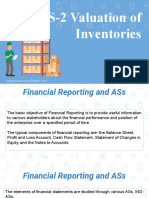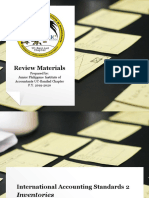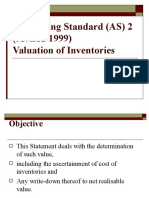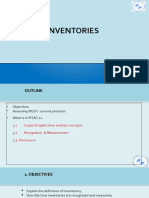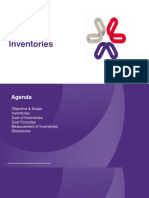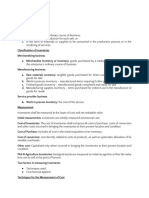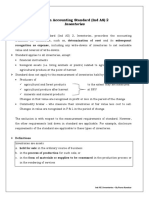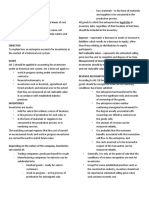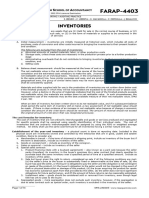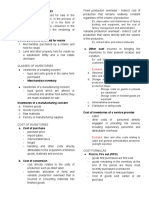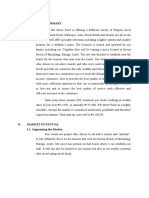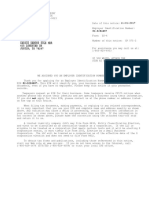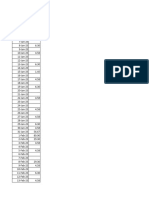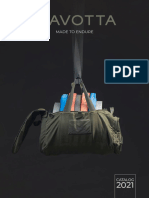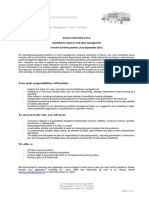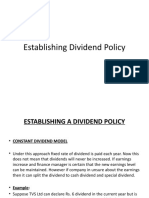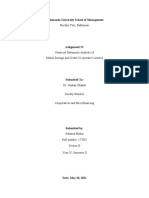October 23
Date: 12 Oct 2023
LIVE LEARNING CLASSES
ORGANISED BY BOS, ICAI
FINAL LEVEL
PAPER 1: FINANCIAL REPORTING
TOPIC: IND AS 2
INVENTORIES
Faculty: CA (Dr.) Alok K. Garg
18 October 2023 © The Institute of Chartered Accountants of India 1
Objective and Scope
The objective is to prescribe the accounting treatment of Inventories.
This standard is applicable to all inventories except,
- Work in progress arising under Construction contracts including directly
related services (Ind AS 115)
- Financial Instruments (Ind AS 32 and Ind AS 109)
- Biological assets related to agricultural activity and agricultural produce at the
point of harvest (Ind AS 41)
- Measurement of Inventories held by Producers of agriculture produce after
harvest and Commodity broker traders measuring inventories at FV less CTS
1
� October 23
Inventory - Definition
Inventories are assets :
in the form of materials
in the process of or supplies to be
held for sale in ordinary
production for such sale, consumed in the
course of business
or production process or in
the rendering of services
Inventory – Key points
Inventory may include intangible assets that are being produced for
resale, e.g. software.
Inventory also includes properties that have been purchased or are
being developed for resale in the ordinary course of business.
Spare parts, stand-by and servicing equipment (e.g. tools and
consumable lubricants) are classified as inventory unless they are
expected to be used during more than one period or can be used
only in connection with an item of PP&E, in which case they are
classified as PP&E
Reusable and returnable packaging or parts that are sold to a
customer, but will be returned to the seller to be reused, are not
inventory if the items will be used during more than one period.
2
� October 23
Inventory – Key points : examples
Measurement of Inventories
Inventories shall be measured at the lower of cost and net realizable
value
Cost includes:
other costs incurred in
Costs of conversion bringing the inventories
costs of purchase
and to their present location
and condition.
3
� October 23
Cost of Inventories - Guidance
• Purchase costs include the purchase
price, transport and handling costs, taxes
Costs of purchase
that are not recoverable and other costs
directly attributable to the purchase.
• When payment for inventory is
deferred beyond normal credit terms,
Deferred payment the arrangement contains a financing
element and interest should be
imputed if the impact is material.
• Trade or volume discounts and rebates
Discounts and rebates on are deducted from the cost of purchase.
purchases
Cost of Inventories - Guidance
Costs of conversion or production
Costs of production or conversion include all direct costs such as labour,
material and direct overheads and an allocation of fixed and variable
production overheads.
These include the depreciation and maintenance of factory buildings and
equipment; amortization of intangible assets such as software used in the
production process; and the cost of factory management and administration.
Labour costs include taxes and employee benefit costs associated with labour
that is involved directly in the production process.
4
� October 23
Cost of Inventories - Guidance
Allocation of fixed overheads
The allocation of fixed production overheads is based on the normal
capacity of production facilities.
Any inefficiencies should be recognized in profit or loss, classified as
other expenses, or, if an entity classifies expenses based on function,
allocated to the appropriate function.
Cost of Inventories - Guidance
5
� October 23
Cost of Inventories - Guidance
Cost of Inventories - Guidance
6
� October 23
Cost of Inventories - Exclusion
Storage costs,
Abnormal unless those costs
amounts of are necessary in
wasted materials, the production
labor or other process before a
production costs further production
stage
Administrative
Selling costs
overheads
Cost of Inventories – Case Study
7
� October 23
Allocation of cost to joint products and by-products
Illustration-Valuation of closing stock
8
� October 23
Illustration-Valuation of closing stock
Illustration-Valuation of closing stock
9
� October 23
Cost Formulas
Specific Identification
■ Goods or services produced and segregated for specific projects shall be assigned by
using specific identification of their individual costs
No specific identification.
■ First-in, First out (FIFO)
■ Weighted average cost formula
LIFO is prohibited under Ind AS.
■ An entity shall use the same cost formula for all inventories having a similar nature and
use to the entity.
■ For inventories with a different nature or use, different cost formulas may be justified.
Techniques for measurement of Costs
Techniques for the measurement of the cost of inventories, such as the standard cost
method or the retail method, may be used for convenience if the results approximate cost.
Retail method is often used in the
Standard costs take into account retail industry for measuring
normal levels of materials and inventories of large numbers of rapidly
supplies, labour, efficiency and changing items with similar margins.
capacity utilization. They are The cost is determined by reducing the
regularly reviewed and, if sales value of the inventory by the
necessary, revised in the light of appropriate percentage gross margin.
current conditions. An average percentage for each retail
department is often used.
10
� October 23
Cost Formulas
Cost Formulas
11
� October 23
Cost Formulas
Cost Formulas
12
� October 23
Cost Formulas
Net Realisable Value (NRV)
Net realizable value is the estimated selling price in the ordinary course of
business less the estimated costs of completion and sale. The costs of sale
include directly attributable marketing and distribution costs.
Estimated Selling Price X
Estimated cost of completion (X)
Selling Costs (X)
---
Net Realisable Value X
13
� October 23
Net Realisable Value (NRV)-Raw Materials
Net Realisable Value (NRV)
Write-downs of inventories and reversals of write-downs
Any write-down of inventories to net realisable value is recognized as an
expense in the period in which the write-down occurs.
A previous write-down of inventories to net realisable value is reversed if the
net realisable value subsequently increases. The amount of the reversal is
limited to the amount of the original write-down such that the new carrying
amount is the lower of cost and the revised net realisable value.
Reversals of previous write-downs are recognized in profit or loss in the period
in which the reversal occurs as a reduction in the amount of inventories
recognized as an expense in the period.
14
� October 23
Illustration
18 October 2023 © The Institute of Chartered Accountants of India 29
Solution
18 October 2023 © The Institute of Chartered Accountants of India 30
15
� October 23
Net Realisable Value (NRV)
Events after the reporting period
Estimates of net realisable value take into consideration fluctuations in price or
cost to the extent that they provide evidence of conditions existing at the end
of the reporting period.
Events after the end of the reporting period may provide evidence that the cost
of inventory exceeds its net realisable value at the reporting date. In these cases
the inventory is written down to its net realisable value at the reporting date.
For example, the carrying amount of Company P's inventory at the end of its 31
December 2011 reporting period is 100. At that date P estimates that the net
realisable value of the inventory is 110. Events in January 2012 provide evidence
that the net realisable value of the inventory at 31 December 2011 was 95.
Therefore, P writes down its inventory to 95 in its 31 December 2011 financial
statements.
Disclosures
■ The accounting policies adopted in measuring inventories, including the cost
of formula used,
■ The total carrying amount of inventories and the carrying amount in
classifications appropriate to the entity,
■ the carrying amount of inventories carried at fair value less costs to sell,
■ the amount of inventories recognized as an expense during the period,
■ the amount of any write-down of inventories recognized as an expense in
the period,
■ the amount of any reversal of any write-down that is recognized as a
reduction, in the amount of inventories recognized as expense,
■ the circumstances or events that led to the reversal of a write-down of
inventories,
■ the carrying amount of inventories pledged as security for liabilities.
16
� October 23
THANK YOU
Presented by :
Alok Kumar Garg
CA, CS, Dip. IFRS (ACCA) UK, CIFRS (ICAI), B.Com (Hons.)
18 October 2023
© The Institute of Chartered Accountants of India 33
17











